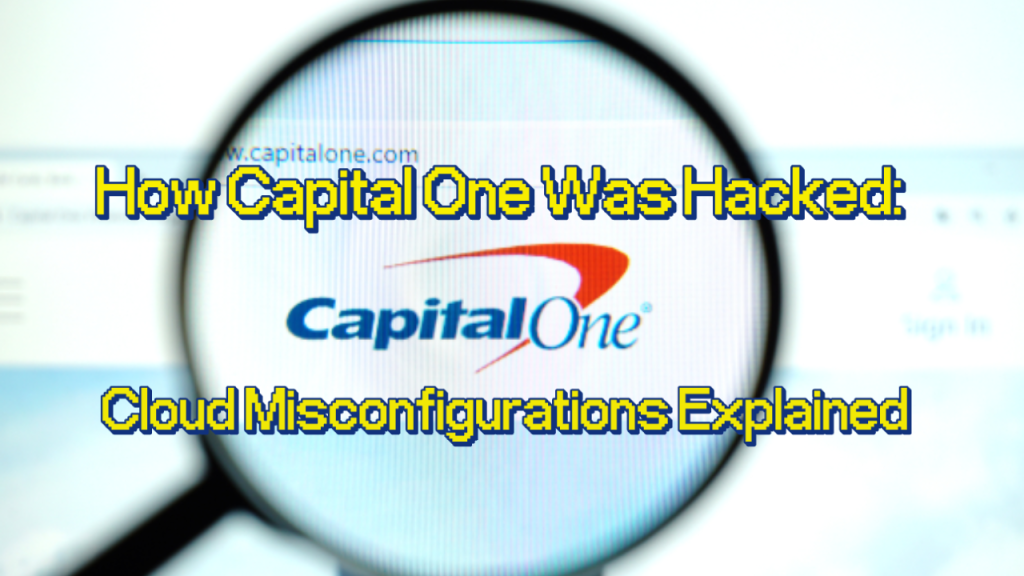The Capital One Data Breach: A Cautionary Tale in Cloud Security
In 2019, Capital One, one of the largest banks in the United States, suffered a massive data breach that compromised the personal information of over 100 million customers. The breach exposed names, addresses, phone numbers, email addresses, credit scores, and even social security numbers.
This breach wasn’t the result of a complex cyberattack or zero-day vulnerability. Instead, it stemmed from a simple misconfiguration in an Amazon Web Services (AWS) environment — an all-too-common mistake that continues to plague organizations as they migrate to the cloud.
In this post, we’ll walk you through what happened, why it happened, and what you can do to prevent your organization from becoming the next headline.
What Happened in the Capital One Breach?
The attacker, a former AWS employee named Paige Thompson, exploited a server-side request forgery (SSRF) vulnerability in a web application firewall (WAF) to gain access to Capital One’s cloud infrastructure. Once inside, she was able to access misconfigured Amazon S3 buckets that contained sensitive customer data.
The key issues that led to the breach included:
Overly permissive IAM roles that allowed excessive access within AWS services.
Misconfigured S3 bucket permissions, making sensitive data vulnerable.
Lack of proper logging and monitoring, delaying detection.
What made this breach especially alarming is that Capital One had already moved its infrastructure to the cloud, aiming to modernize and improve its security posture. However, this incident highlighted that cloud security is a shared responsibility — and even well-intentioned configurations can lead to disaster if not reviewed and tested properly.
Lessons Learned: Cloud Security Best Practices
1. Understand IAM and Least Privilege Access
One of the core issues in the Capital One breach was the misuse of AWS Identity and Access Management (IAM) policies. Following the principle of least privilege means that users and systems should have the minimum access they need to perform their functions — nothing more.
Regularly audit IAM roles and permissions and avoid wildcard policies that grant broad access.
2. Secure Your S3 Buckets
Misconfigured S3 buckets have been at the heart of numerous breaches. Always:
Enable “Block all public access“
Use bucket policies to restrict access
Encrypt your data using server-side encryption (SSE)
3. Enable Logging and Monitoring
Tools like AWS CloudTrail, Amazon GuardDuty, and AWS Config can help you detect anomalies, monitor access patterns, and receive alerts about misconfigurations in real time.
4. Regularly Test Your Cloud Security Posture
Cloud infrastructure is dynamic. As such, your security configurations must evolve. Regularly test your environment using penetration tests, red teaming, or automated tools like AWS Inspector or third-party scanners.
Recommended Training: Hacking and Securing Cloud Infrastructure
If you’re serious about cloud security, I highly recommend checking out NotSoSecure’s course, Hacking and Securing Cloud Infrastructure. Their instructors are ethical hackers with real-world experience, spending over 50% of their time on active security projects.
This training dives deep into vulnerabilities in AWS, Azure, and GCP, including:
IAM misconfigurations
Container security issues
Storage exposure scenarios
🎓 Learn more about the course here: Hacking and Securing Cloud Infrastructure | NotSoSecure
💰 Bonus: Get a 20% discount by emailing nss-training@claranet.com and mentioning my name.
NotSoSecure is part of Claranet, a leading provider of cloud solutions. Explore their services here: Claranet Cloud Services
Watch the Full Breakdown
In the video below, I walk through the Capital One breach step by step and show how a simple misconfiguration snowballed into one of the largest data breaches in banking history.
🎥 Watch now:
Final Thoughts
The Capital One breach serves as a critical reminder that misconfigurations can be just as dangerous as malware or zero-days. As we continue to shift workloads to the cloud, understanding and implementing cloud misconfiguration prevention strategies is no longer optional — it’s essential.
Don’t wait for a breach to rethink your cloud strategy. Invest in training, review your configurations, and stay ahead of evolving threats.
If you found this article helpful, consider subscribing to my YouTube channel for more cloud security breakdowns: youtube.com/c/lufsec
#CapitalOneBreach #CloudSecurity #AWS #CyberSecurity #S3Buckets #IAM #NotSoSecure #Claranet #DataBreach #CloudTraining #Lufsec #CloudMisconfiguration

